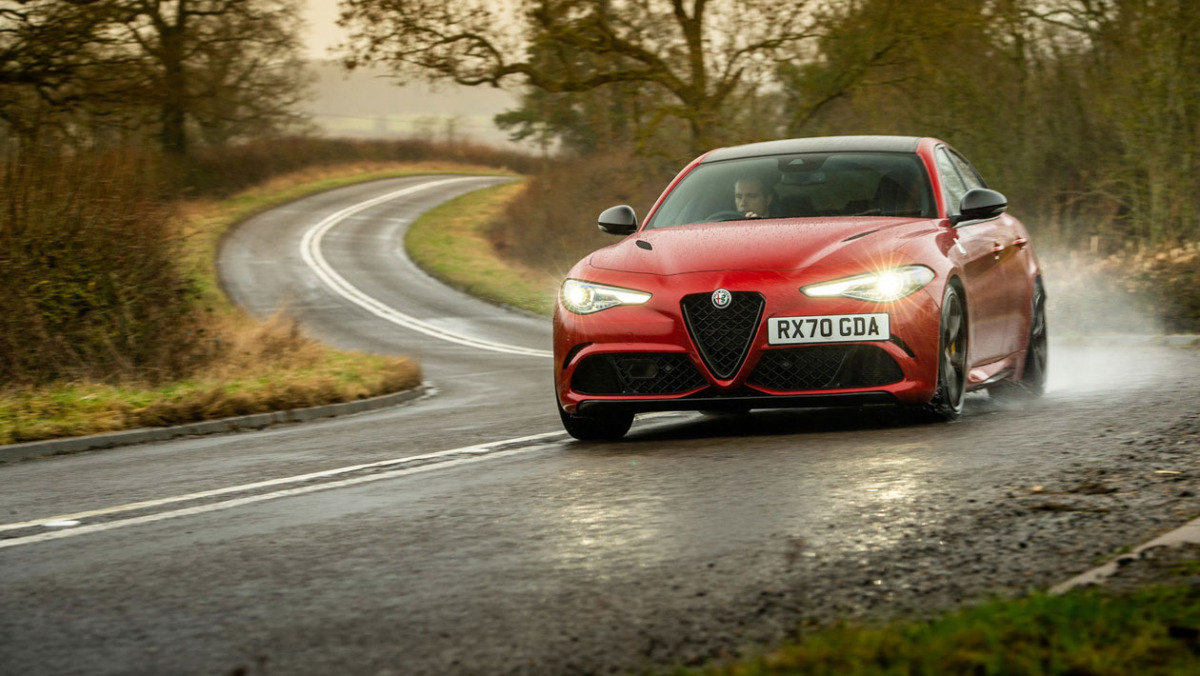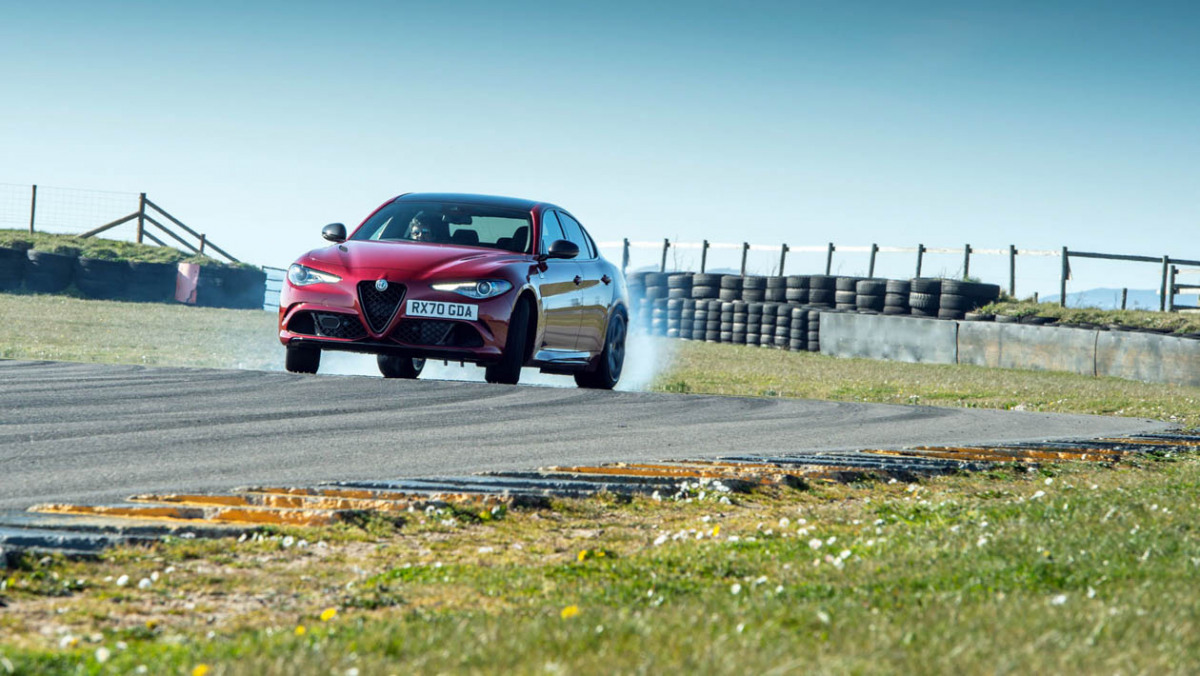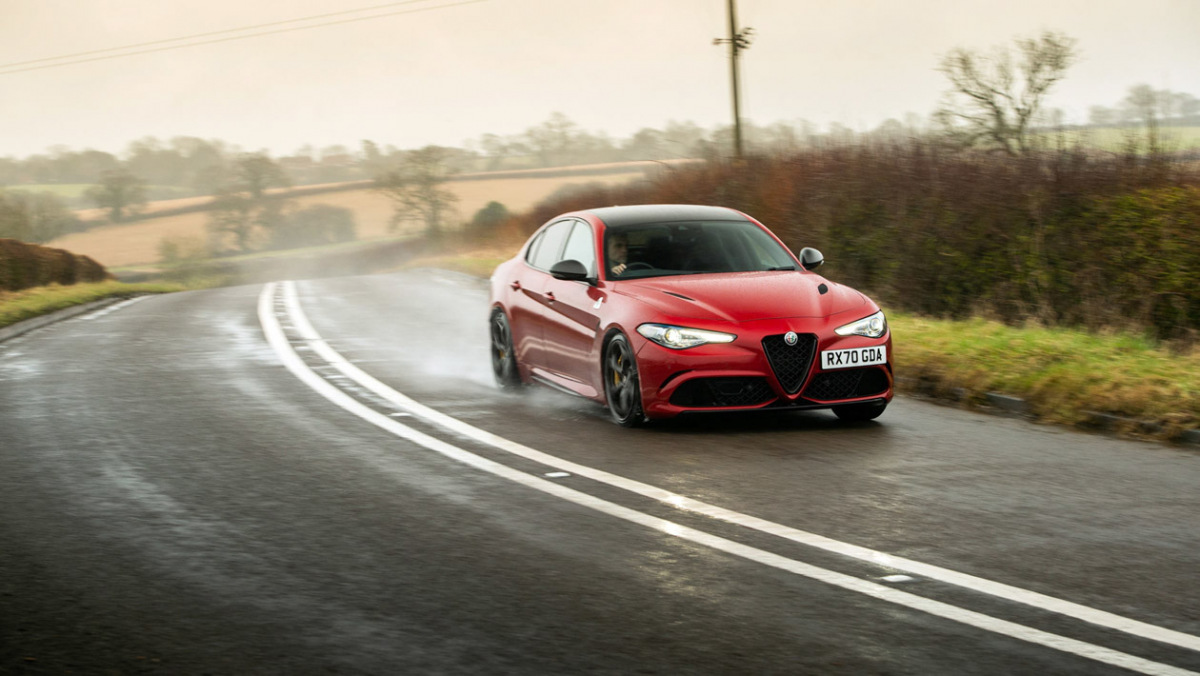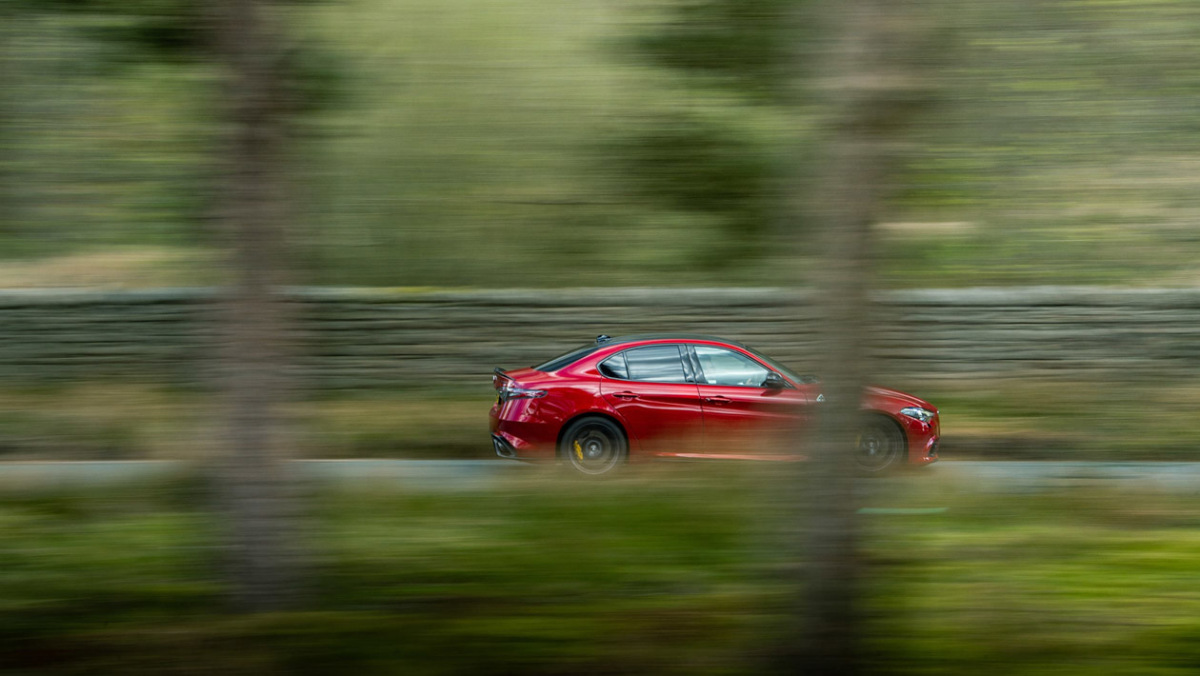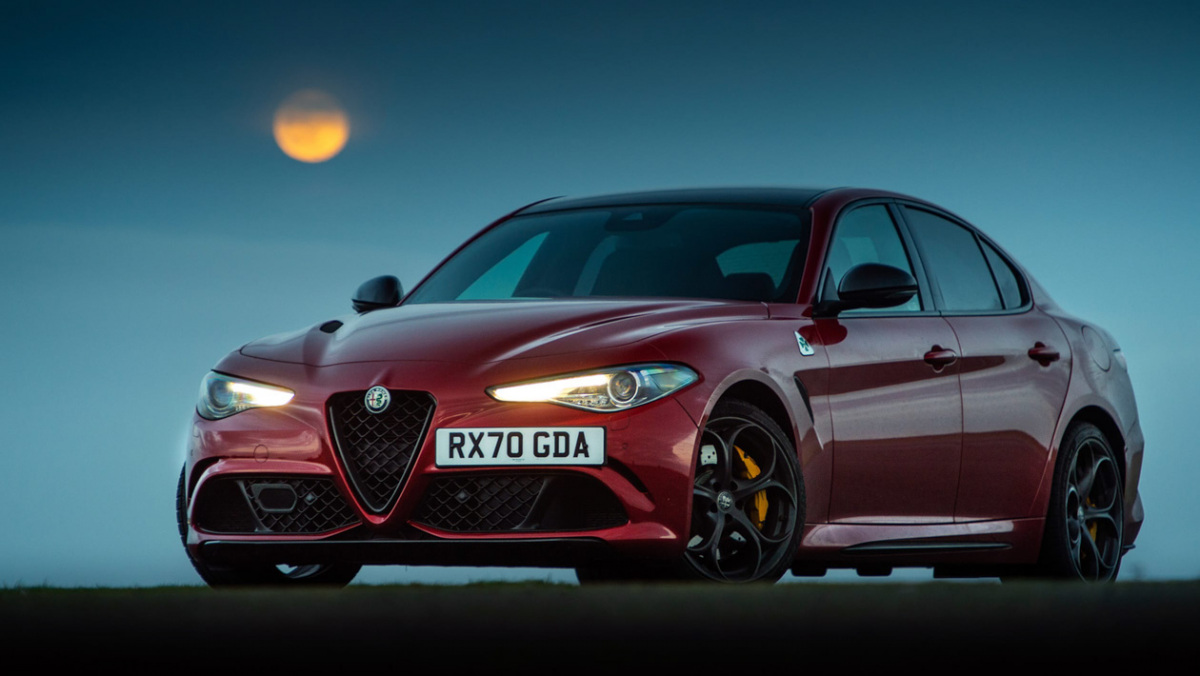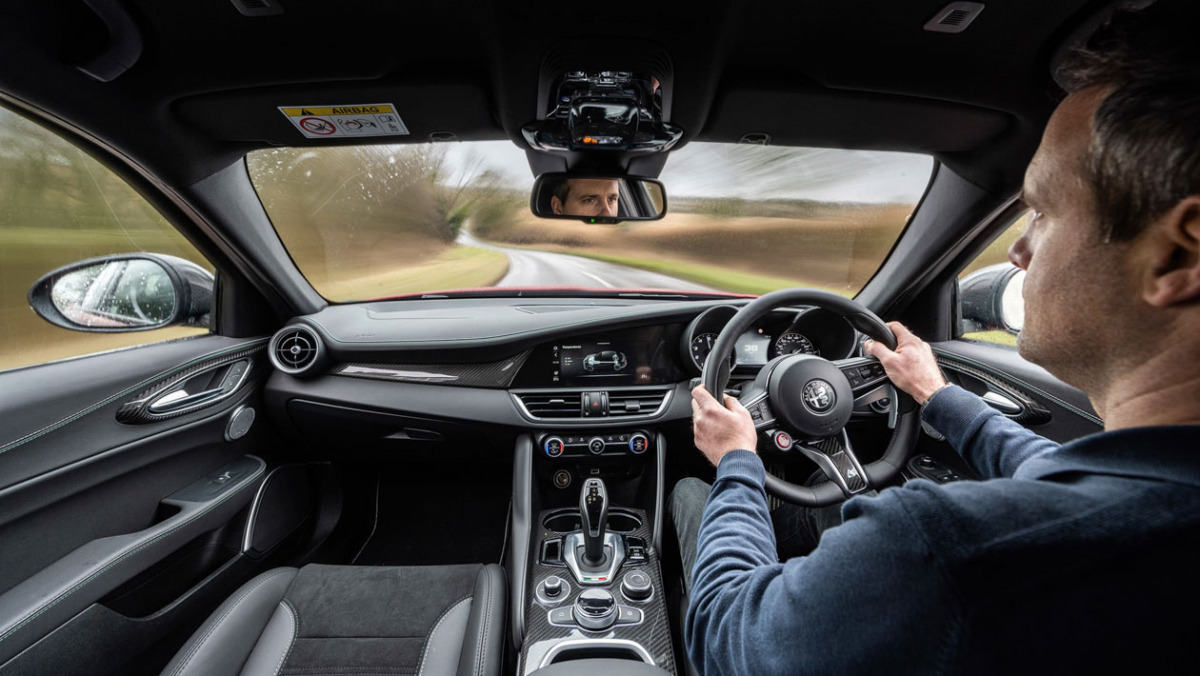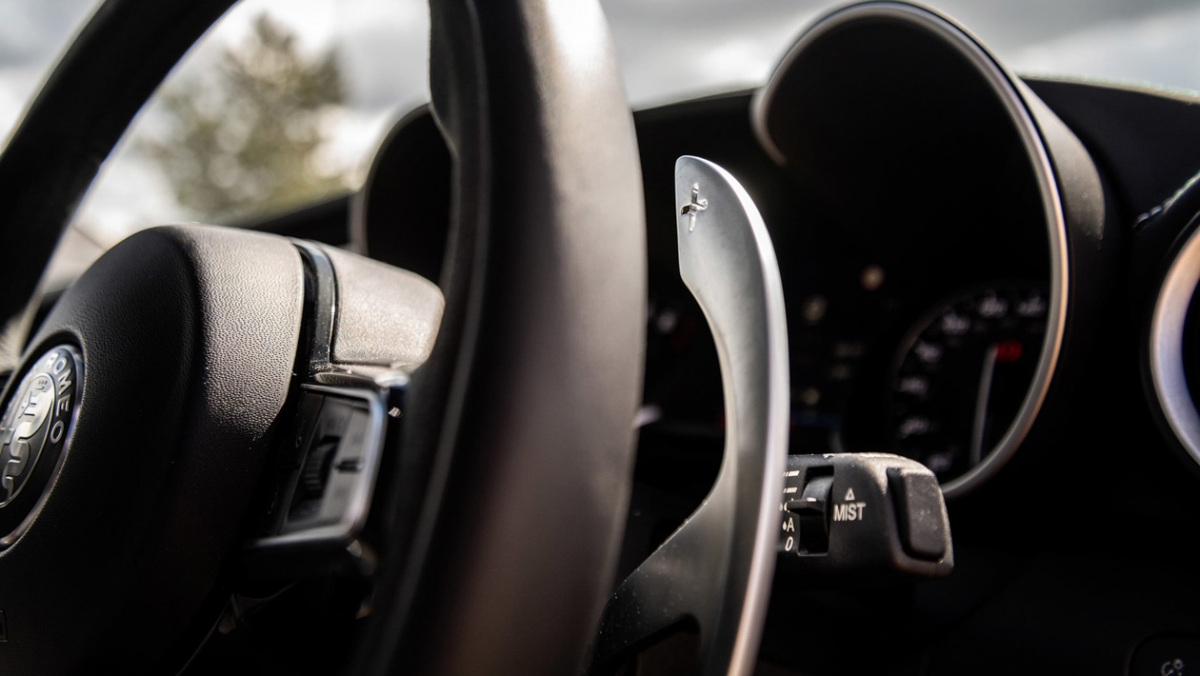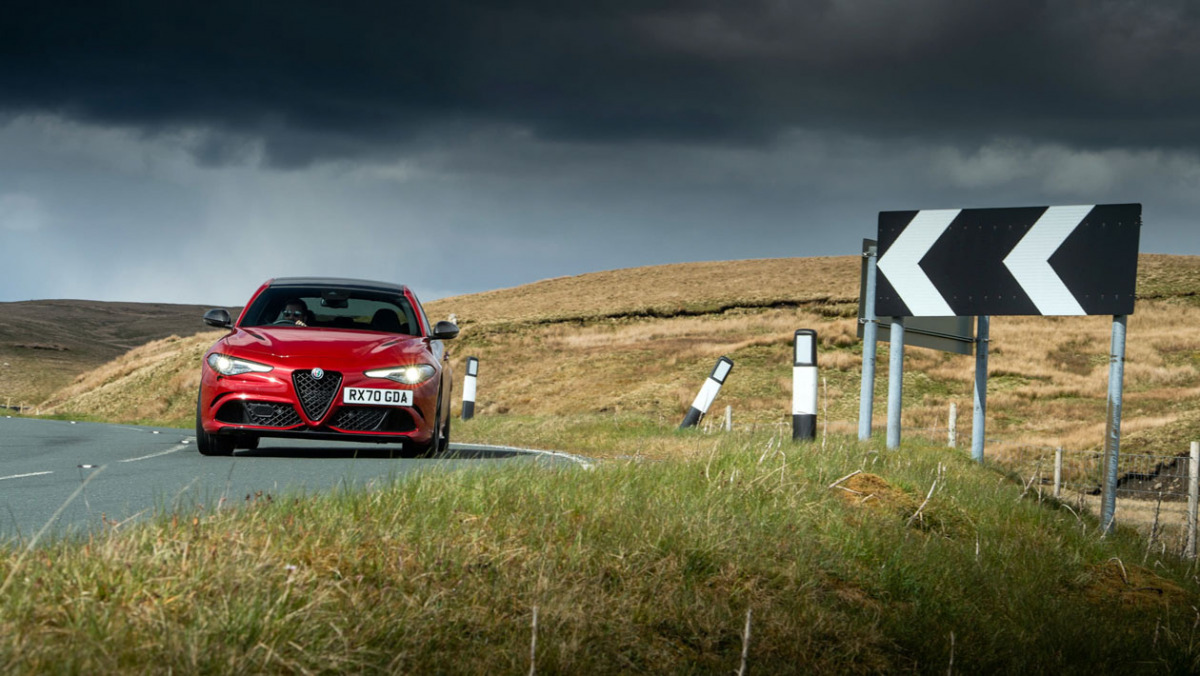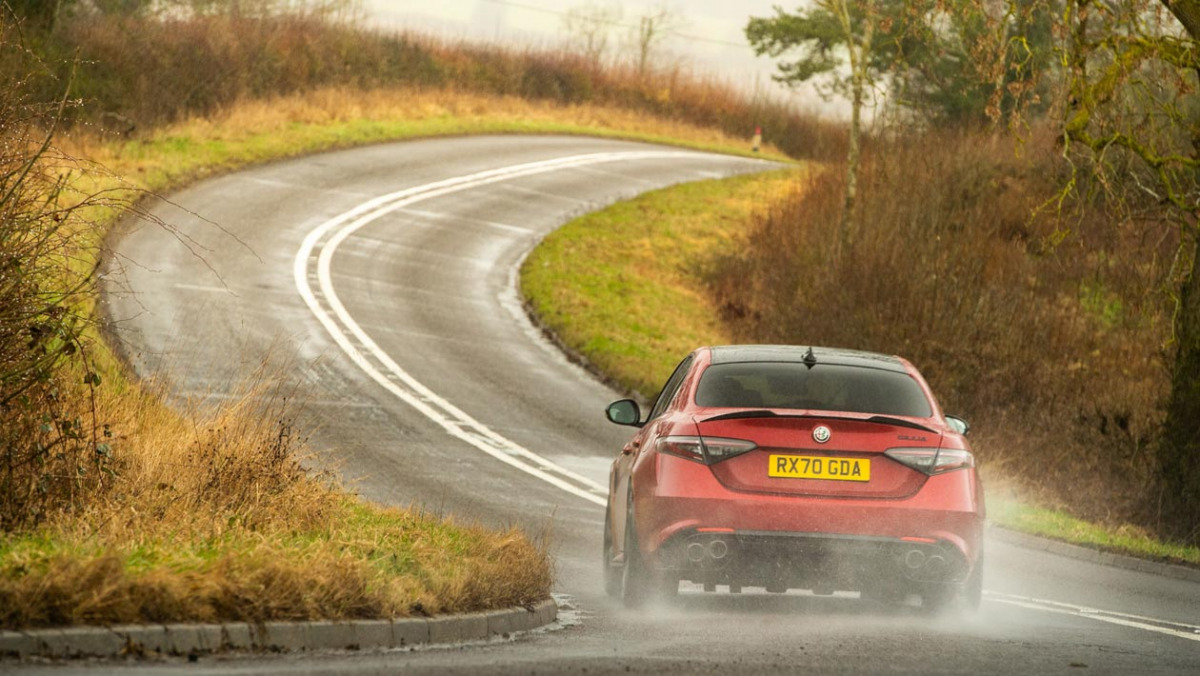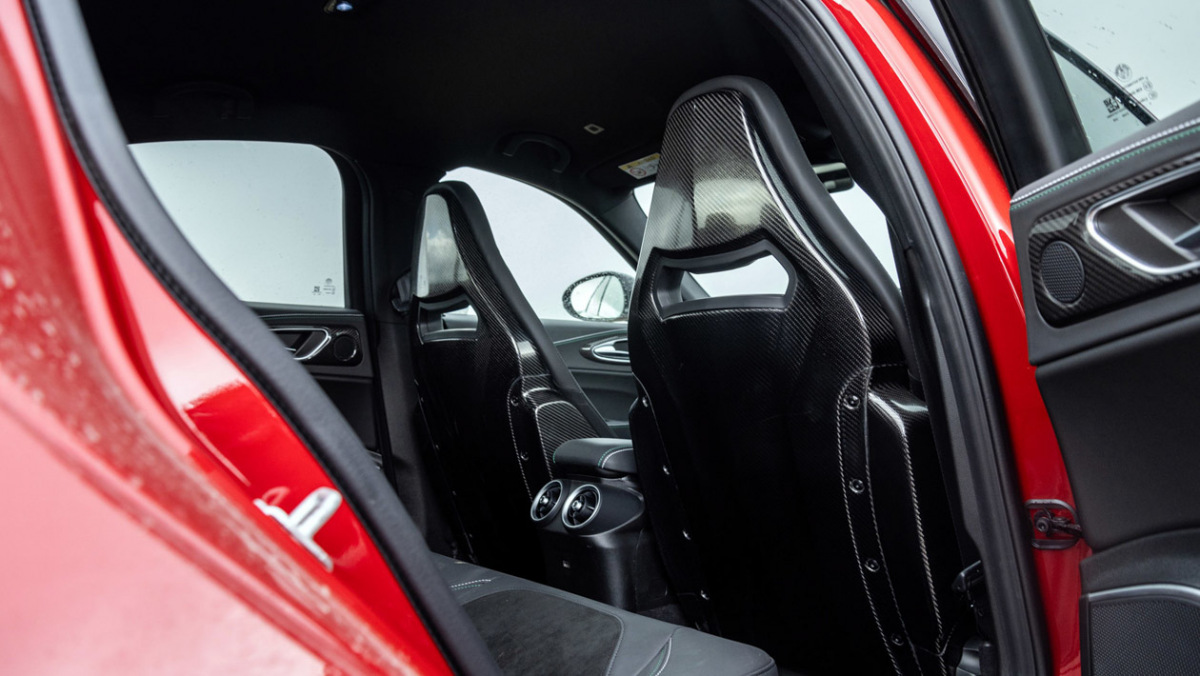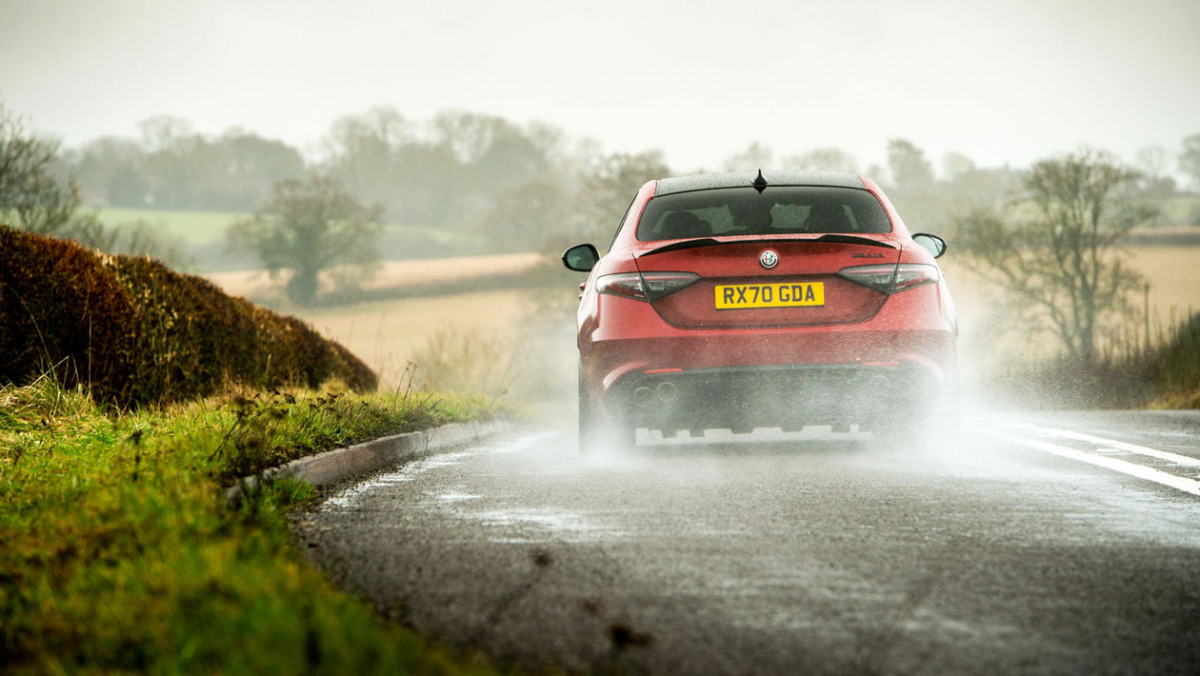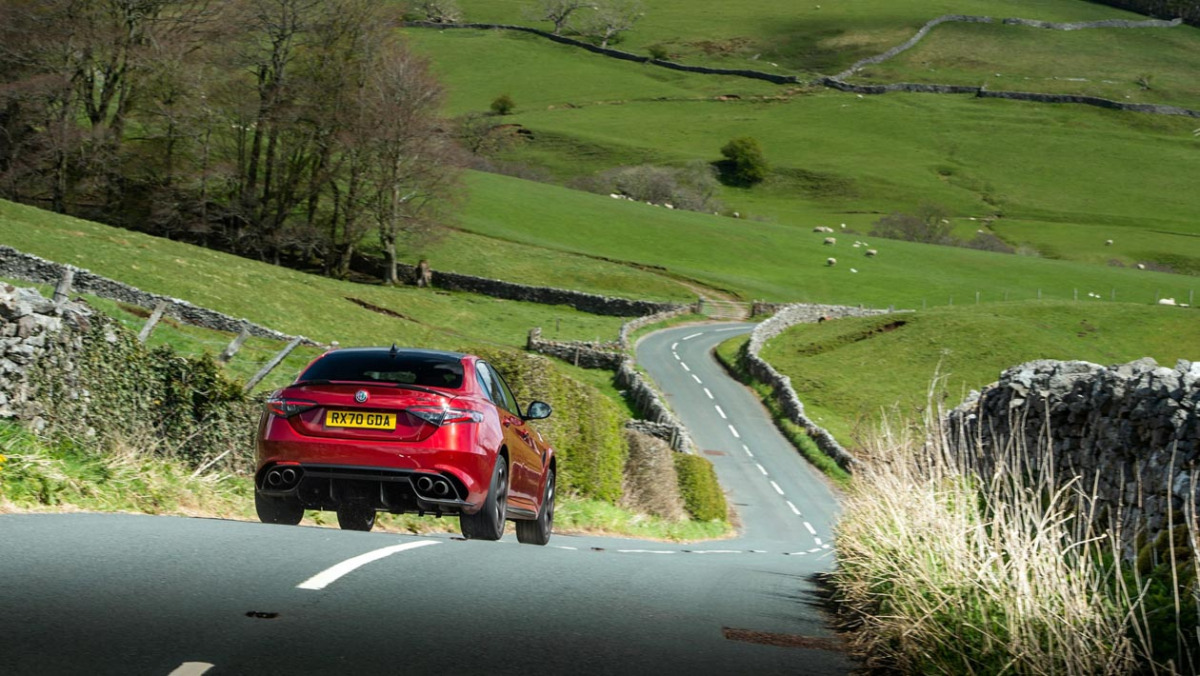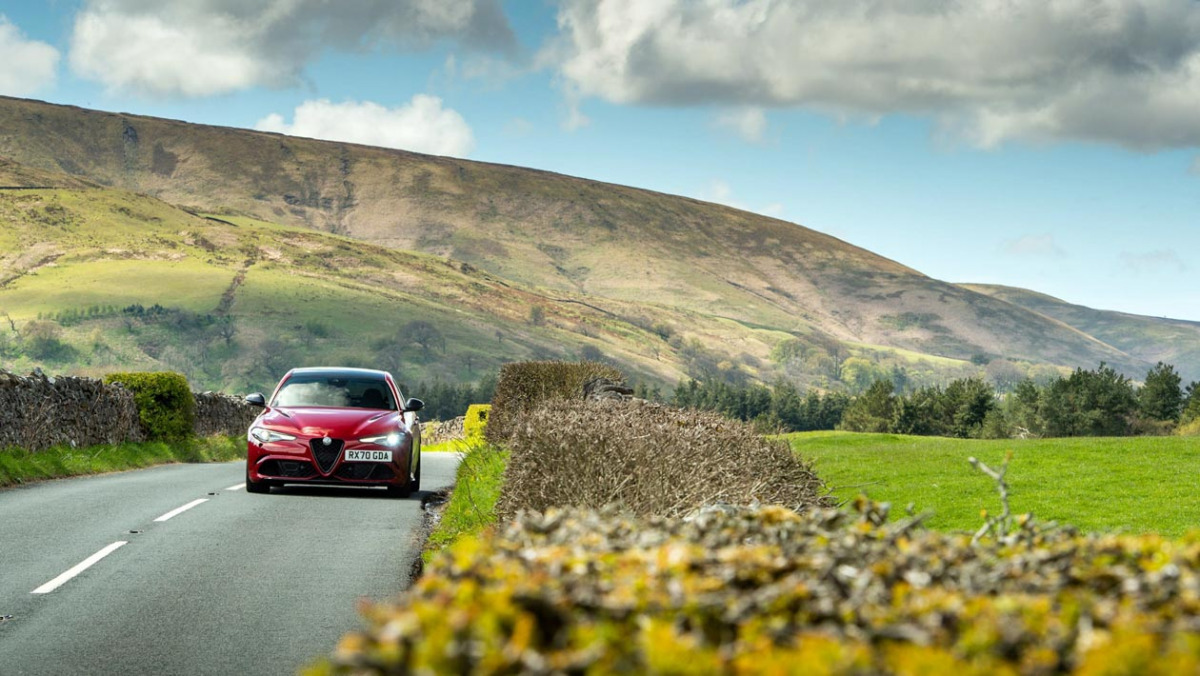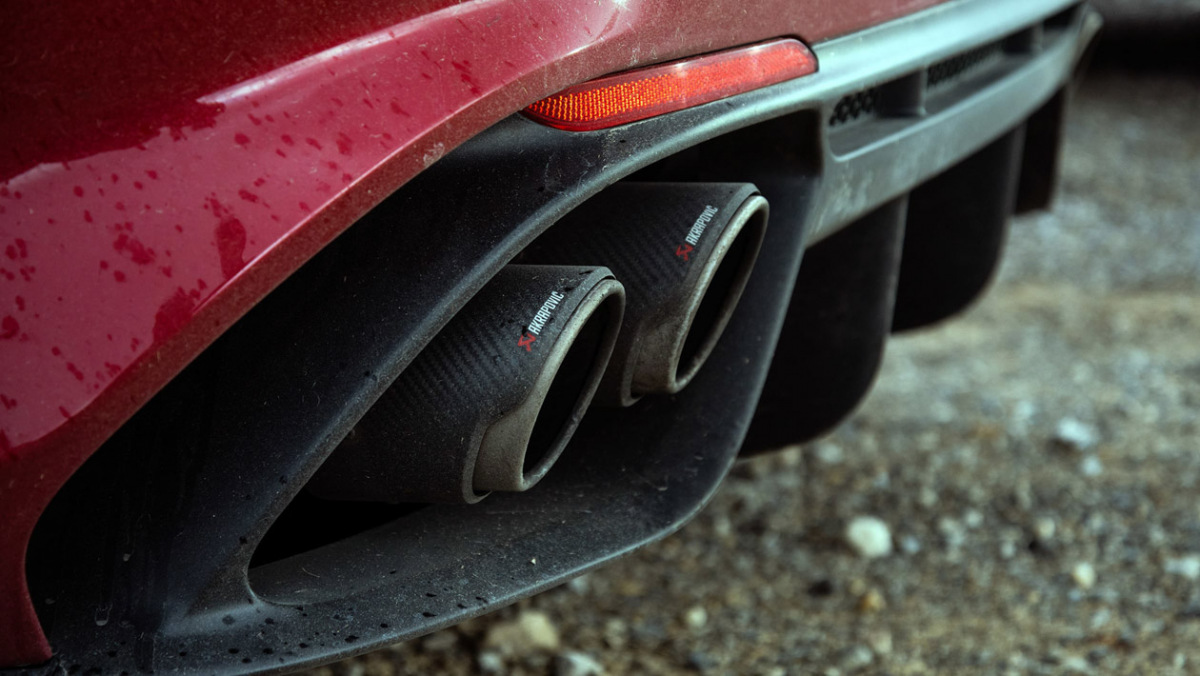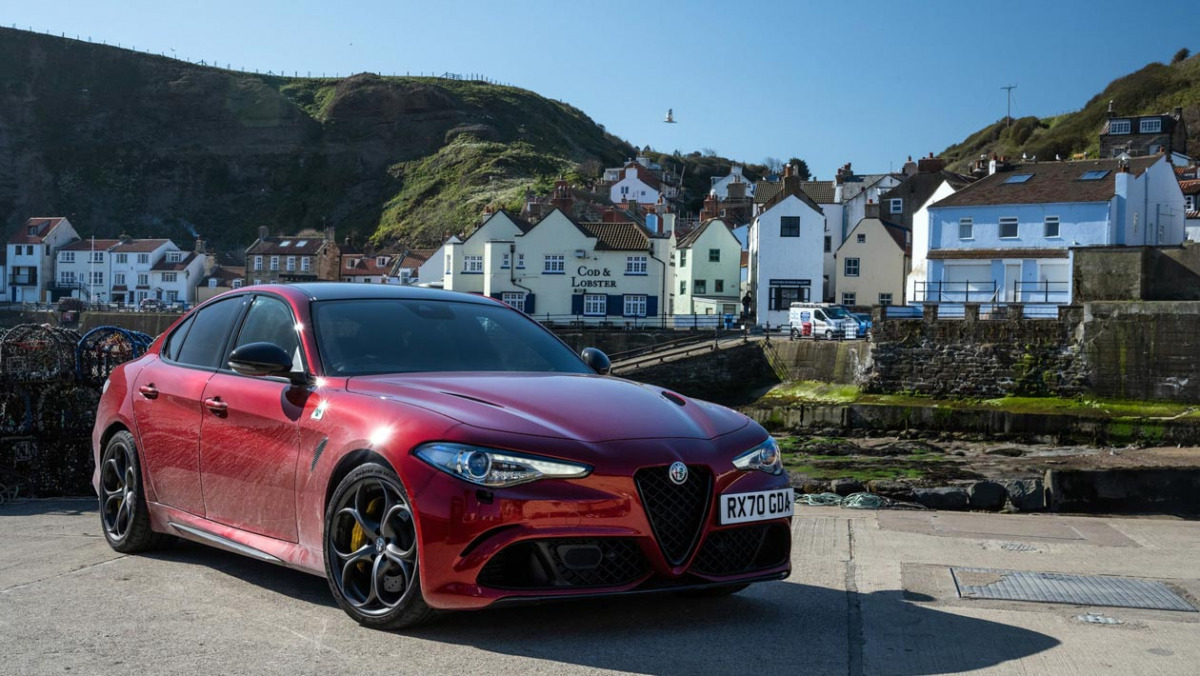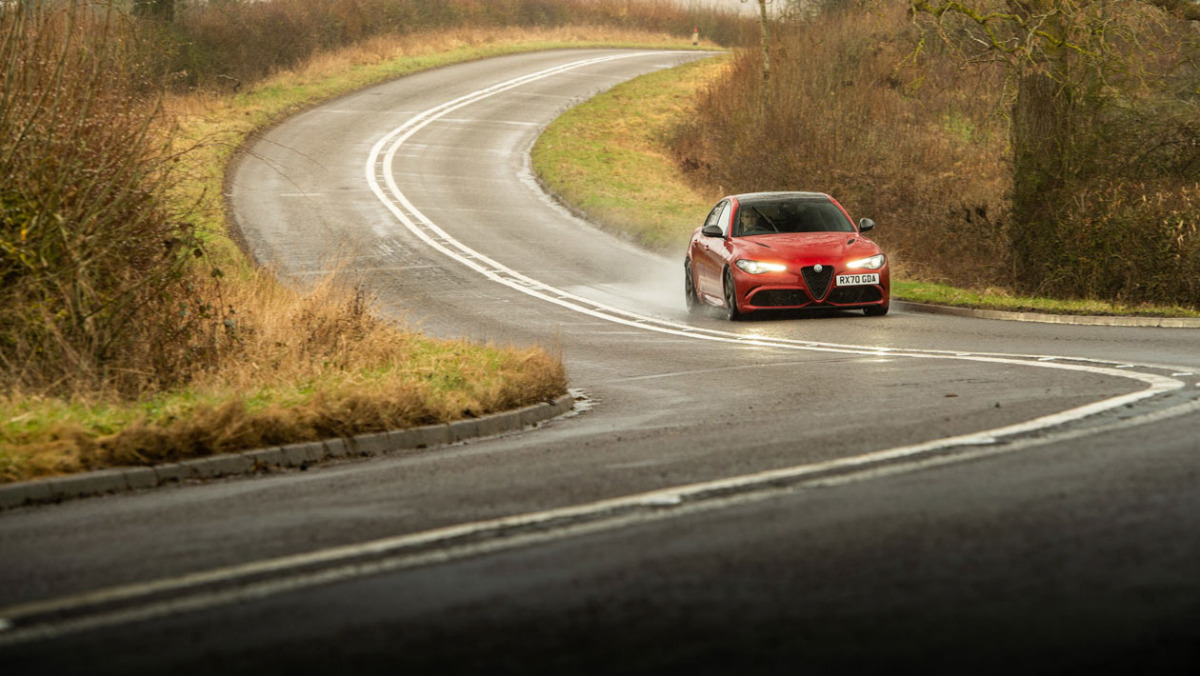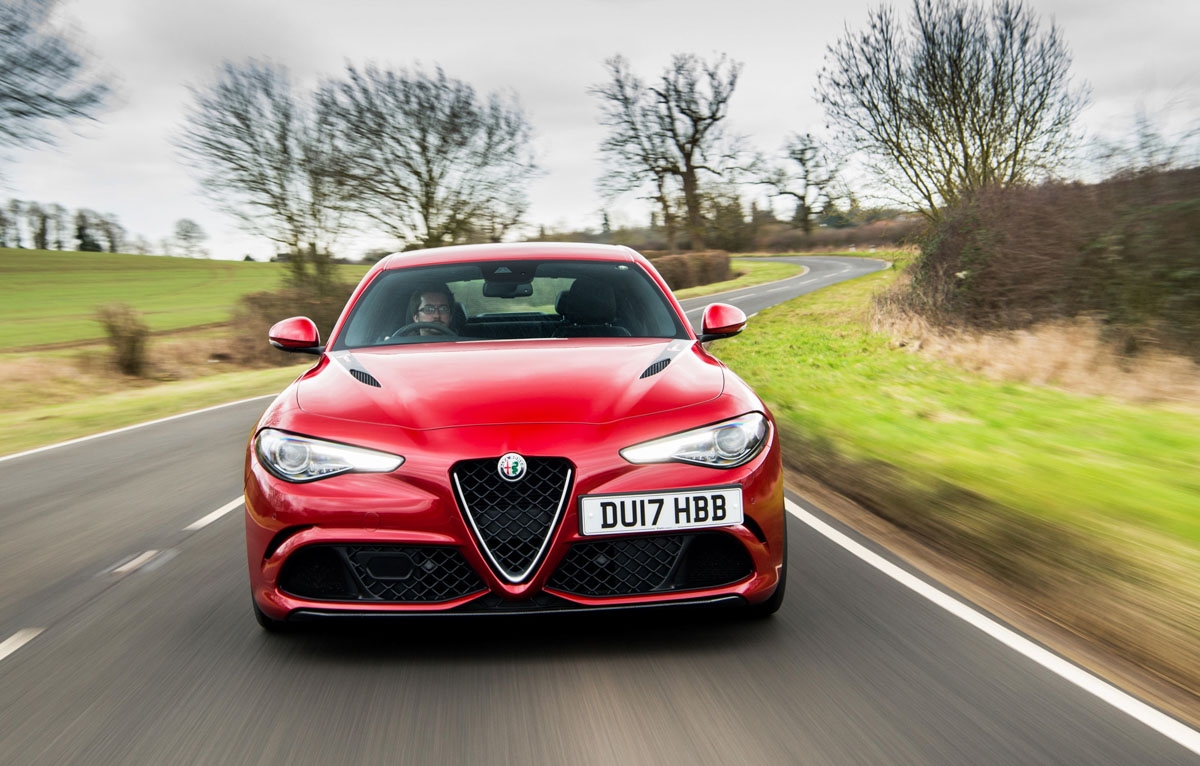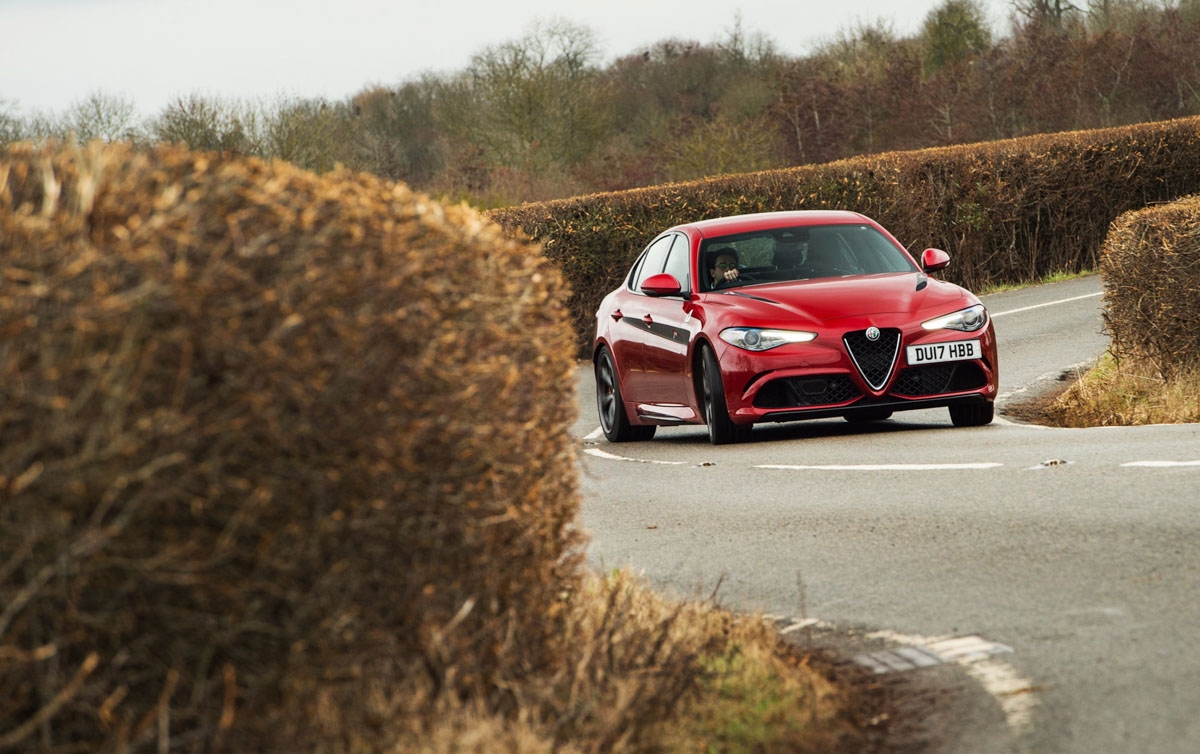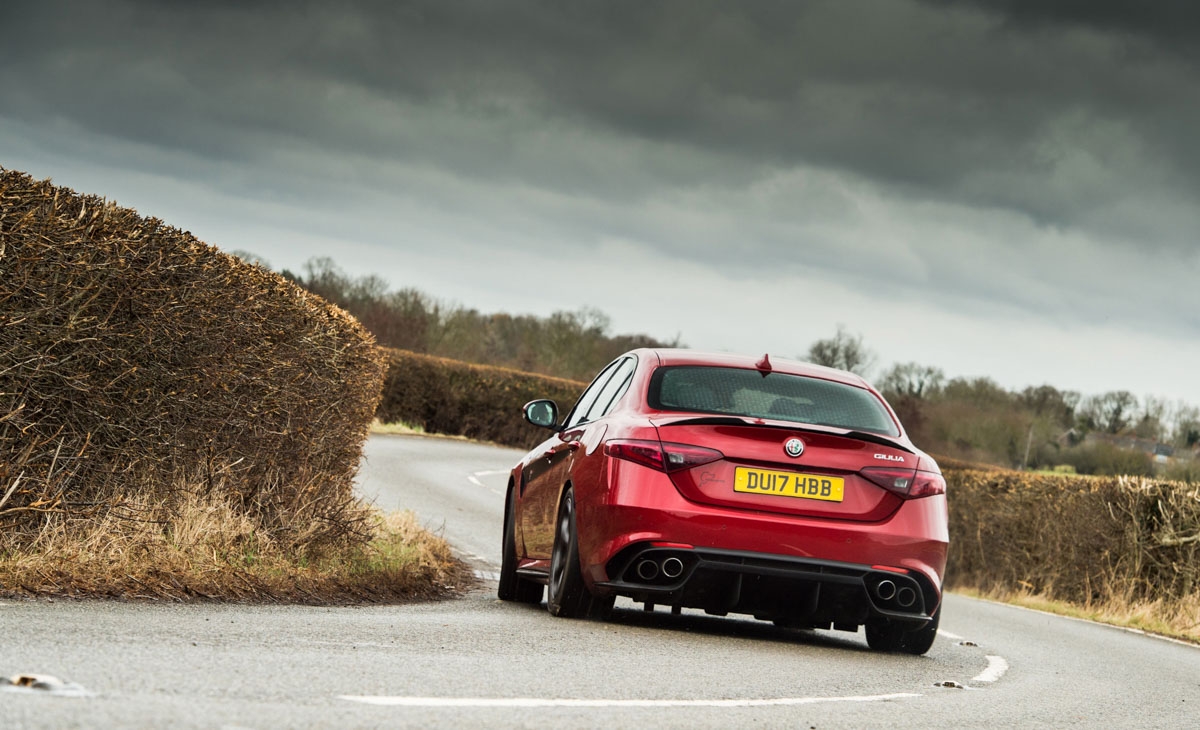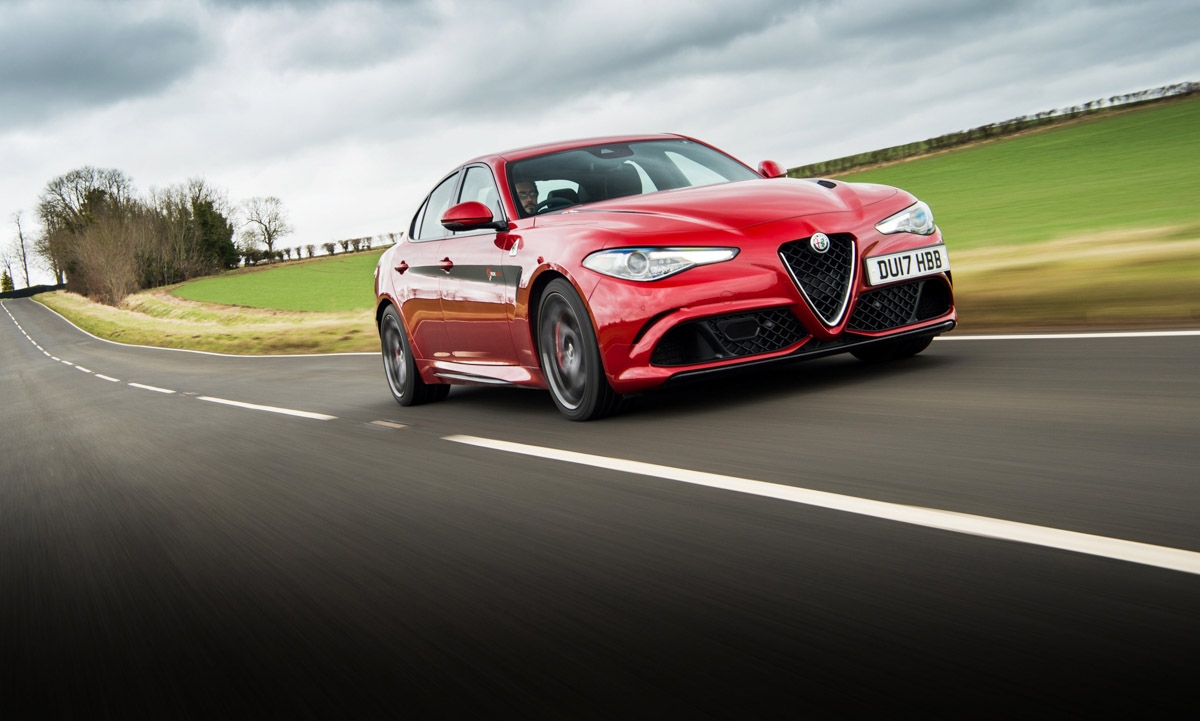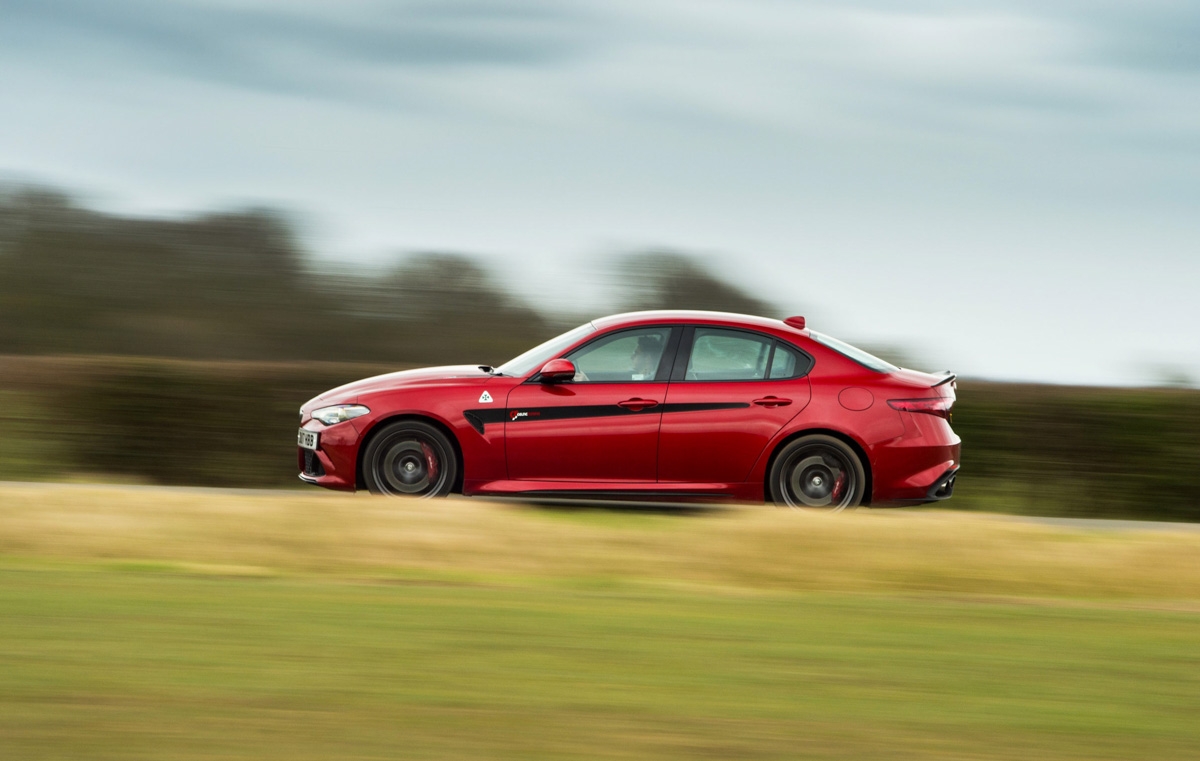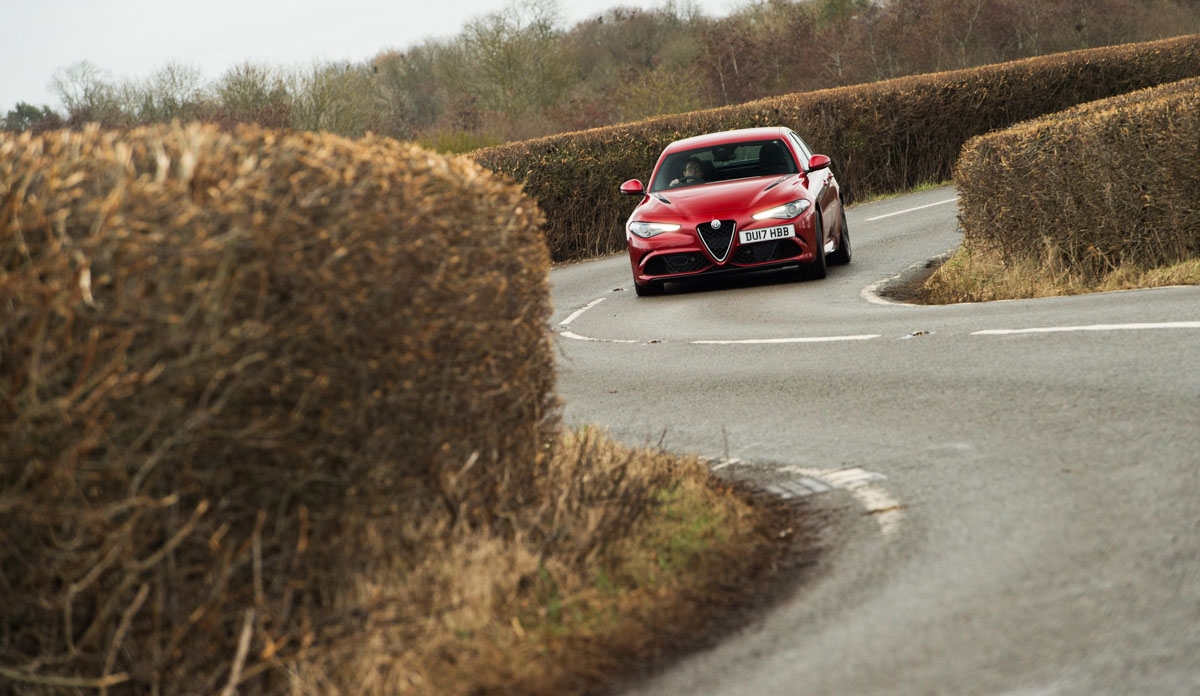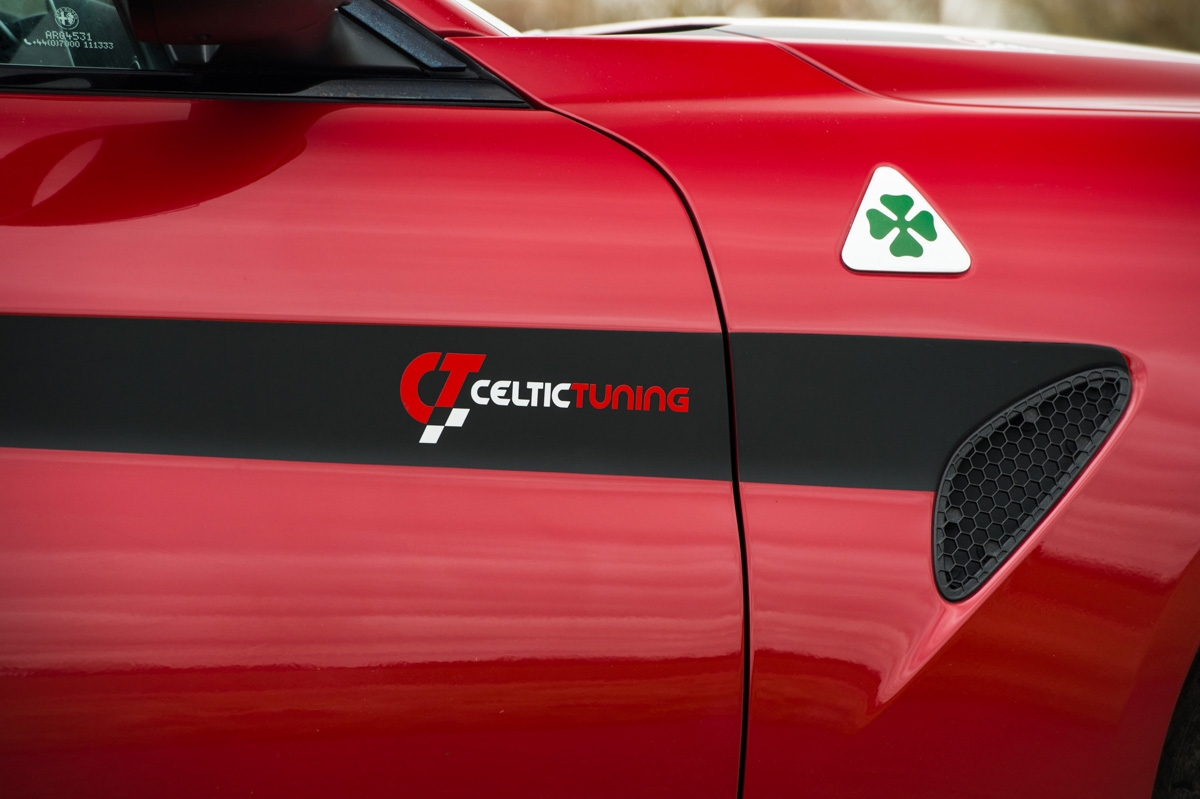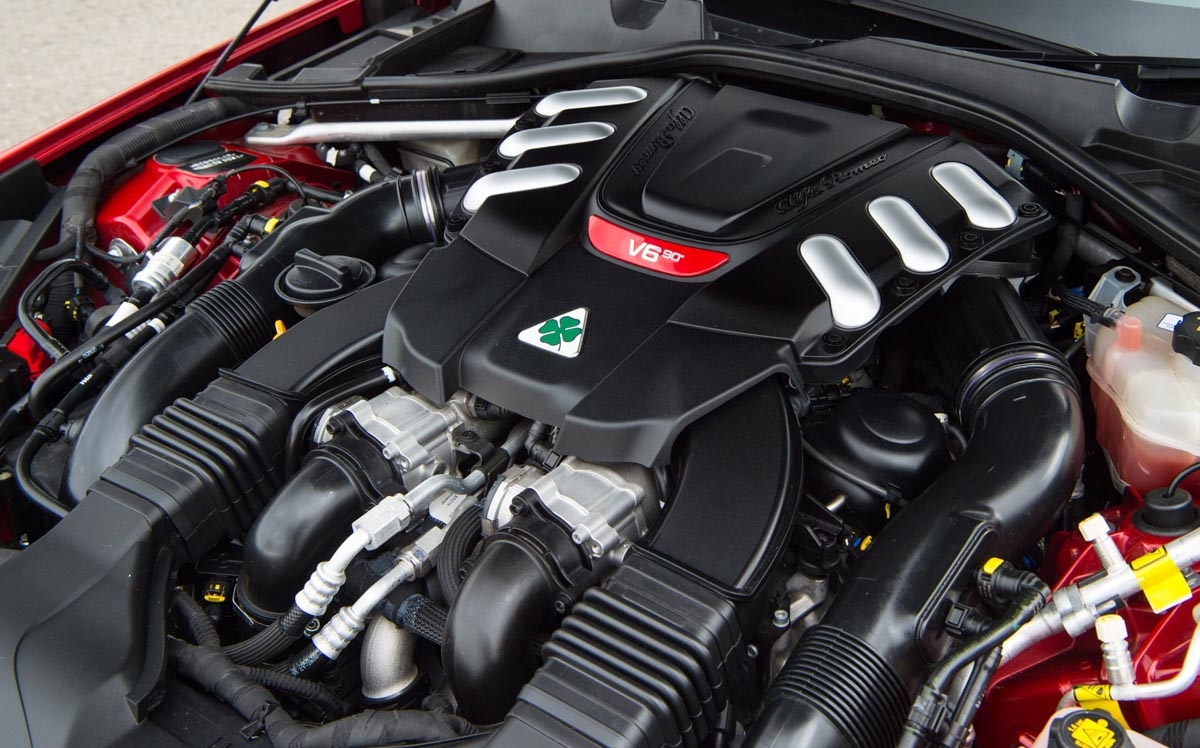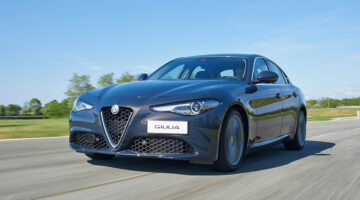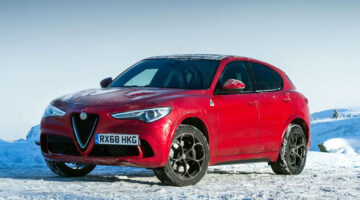It was designed to take on the BMW M3, but stole our hearts along the way – the Alfa Romeo Giulia Quadrifoglio is masterpiece
| Impressively fast, amazingly approachable | |
| Perhaps not as pretty as an Alfa should be, quirky low speed behaviour |
PRICE from $89,490
The Alfa Romeo Giulia Quadrifoglio has been a prominent figure within evo since it burst out onto the scene in 2017, and for good reason as quite simply, the Giulia Quadrifoglio is a spectacular supersaloon.
The ingredients on their own make for interesting reading: rear-wheel drive, a 503bhp twin-turbo V6 engine, a (contextually) featherweight 1524kg kerb weight and an extremely focused chassis, but what really makes the Alfa shine is how each of these elements work together.
All of this excellence seemingly came from nowhere too, with Alfa Romeo enlisting a crack skunkworks-like team of designers and engineers to design almost every part of the Giulia from scratch without any real oversight – how Italian. It went through a (very) light update in 2020, the only notable updates being an improved digital interface, an optional Akrapovic exhaust and properly-finished gear selector, but the fundamentals remain.
Yet not only is the Quadrifoglio a great attempt at a supersaloon, it leaves plenty of the German establishment with bloody noses. And this is from a company which hasn’t competed in this sector for at least a decade, and hasn’t produced a contender for the top spot since the 1960s.
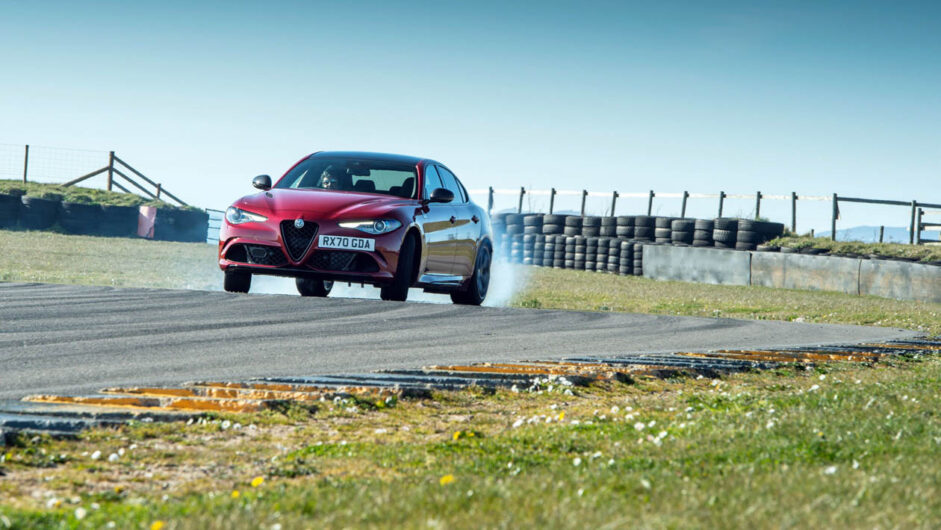
Prices, specs and rivals
The Alfa Romeo Giulia Quadrifoglio starts from $95,137. That might seem like a lot in isolation, but the rivals have accelerated way past that entry-price, and in the Alfa’s case does include an array of exotic carbonfibre body parts and components, an awful lot of power, a high-tech diff and plenty of Alcantara inside.
There aren’t many options, but the ones you might want to choose are expensive. Carbon ceramic brakes are a $8300 extra, although the strange pedal feel and odd low speed behaviour that comes with them could put you off spending that sum. What you will want to fork out for are the carbonfibre-backed Sparco bucket seats at $4500; not only do they look great, but they’re some of the most comfortable and supportive seats in any performance car currently for sale. That new Akrapovic exhaust system is also $4500, and there’s also a new carbonfibre roof option for $2800, uprated sound system at $1300 and the Alcantara/Carbon steering wheel at a very reasonable $550. All-in, a fully loaded Giulia will slip just underneath the $115k mark, making it much less expensive than a similarly specced M3.
The next generation Mercedes-AMG C63 S saloon is still in the works, but very controversially will do without its V8 engine and utilise the turbo-four and electric rear axle combination AMG revealed in ealy 2021.
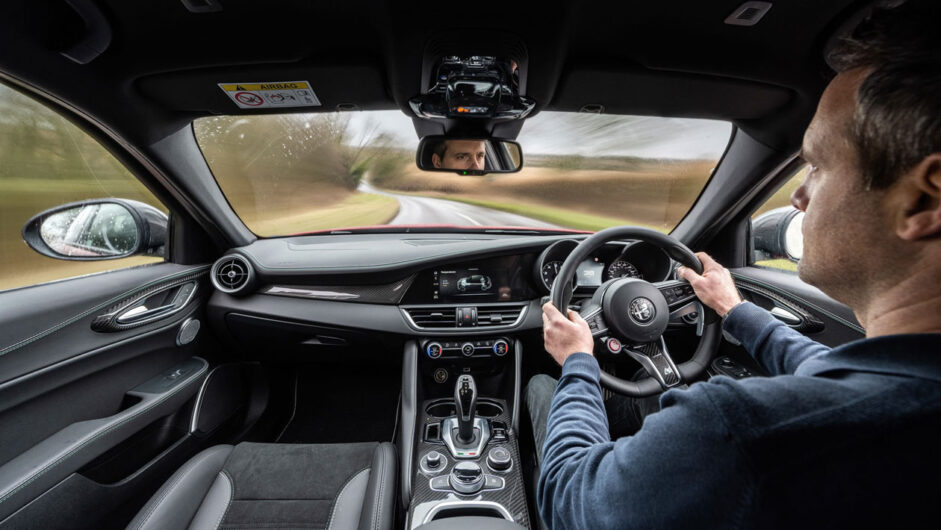
The BMW M3 has long been at the top of the tree in this sector and the new G80 Competition is no exception. Now producing the same power as the Alfa, its key disadvantage is a weight penalty over the featherweight Giulia, but hits back with a superb chassis and real engagement. Its engine and transmission do lack the Alfa’s crispness, and the styling is a turn off for some (ok, most) but the M3 v Giulia rivalry has never been closer.
Much like it’s German rivals, the Giulia is gaining lots of attention from aftermarket tuners – its forced induction system making it relatively easy for ECU tuners to find a little more power from its engine. As well as modifying the exhaust to make it the car loud the entire time, Celtic Tuning has managed to extract 585bhp and 489lb ft of torque from the Giulia’s V6. The whole package costs just $800, too.
- Performance and 0-100 time
Even by today’s ludicrous standards of power, the Alfa Romeo Giulia Quadrifoglio’s 503bhp is impressive. But rather than relying solely on the engine’s grunt to produce some outstanding performance figures the Giulia is also impressively light.
To keep weight down it comes with a carbonfibre propshaft, bonnet, roof and front splitter. The subframes are made from aluminum, as is the engine. All these exotic materials result in a claimed dry weight of 1524kg.
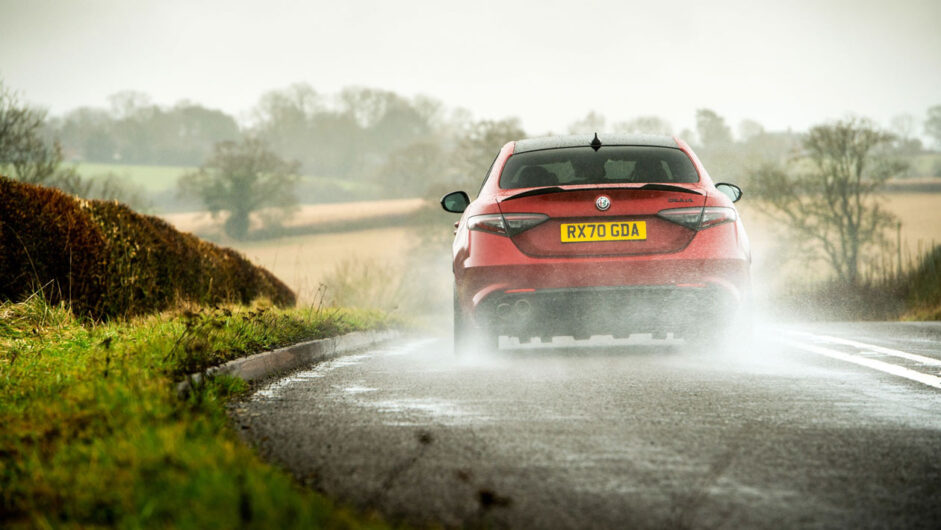
As such, Alfa says the Giulia can accelerate from 0 to 100kph in 3.9sec and go onto a top speed of 307kph. It also says its supersaloon can lap the Nuburgring in 7:39sec. When we lapped it around Bedford Autodrome, we set a time of 1:23.6sec – the fastest saloon we have ever timed around the circuit.
- Engine and gearbox
Like many of the great Alfas of old the Giulia Quadrifoglio is powered by a V6. Its 2.9-litre twin-turbocharged motor might not have the reputation, or emit the same acoustics, as Alfa’s legendary Busso engine but it shares plenty of DNA with the V8 found in the front of a Ferrari California T. What more provenance do you need?
> Ferrari California T review – Is the California T a true Ferrari?
If you’re not impressed by the Marenello connection then the Alfa V6 has some notable figures to wow you instead. It puts out 503bhp at 6500rpm, revs to 7000rpm and produces 442lb ft of torque between 1800 and 5500rpm. It isn’t the revviest engine, but it delivers its performance in such a linear and manageable manner that you don’t lament the opportunity to stretch the motor beyond the conservative limiter.
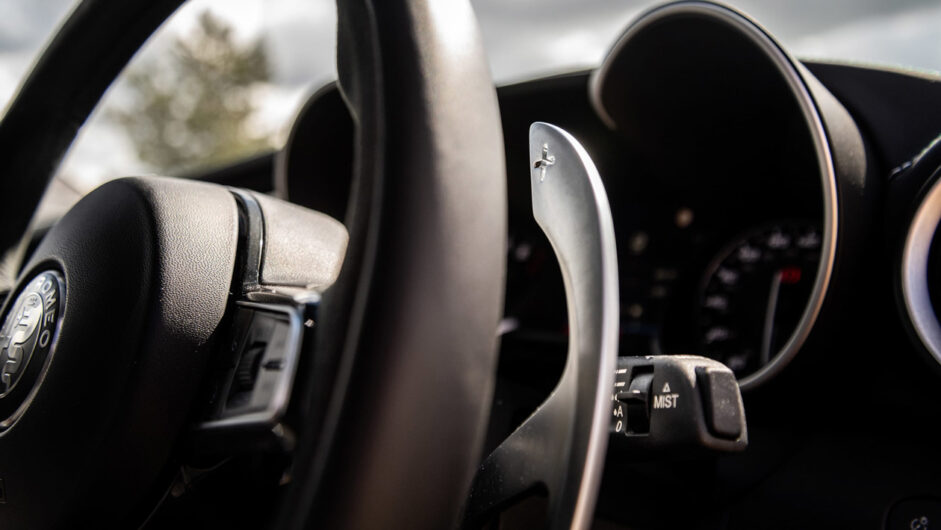
Here there is no choice of transmission: an eight-speed automatic gearbox is all you get. Yes, it’s that same ZF unit that BMW, Jaguar, Aston Martin, Audi, Land Rover and Maserati use. Left hand drive cars can be ordered with a six-speed manual gearbox. The purists in the region, such as us, might be left a little disappointed with not being given the option to select gears themselves.
If we’re being honest though, the automatic gearbox suits the Giulia better than the manual. We’re not just saying that to make ourselves feel better either; the notchy and long throw of the Giulia’s manual shift would take a lot of getting used to, whereas the fast, smooth shifts from the eight-speed auto are practically faultless.
Drive is then sent to the rear wheels via a carbonfibre propshaft and electronically controlled limited slip differential, that can not only vary the amount lock across the rear axle, but can actively send torque to a certain wheel to create torque vectoring, too.
- Ride and handling
Before you even start the Giulia Quadrifoglio you get the feeling that the team behind this car really cares about driving. You sit low, with your entire body cupped by the optional carbonfibre-backed Sparco seats. The huge range of adjustment on the steering column means you can pull the steering wheel into the exact position you want, too.
The starter button is positioned on the steering wheel while two long aluminium paddles, that follow the curve of the rim, are actually mounted on the column. Both feel very Ferrari-esque indeed. But that’s no surprise, because Alfa poached engineers from Ferrari to help develop the Giulia.
Another aspect of the Alfa that feels oh-so Ferrari is the steering. Just metres down a road you become aware that the Giulia has a very fast steering rack indeed, more than a little reminiscent of that found in the Ferrari 458 and 488, no less.
The perfect seating position and super fast steering instil a confidence in you that you could deal, react and drive through just about any situation with supreme accuracy; the conviction that you’d be able to tame a wild and unruly rear-wheel drive turbocharged car with ease.
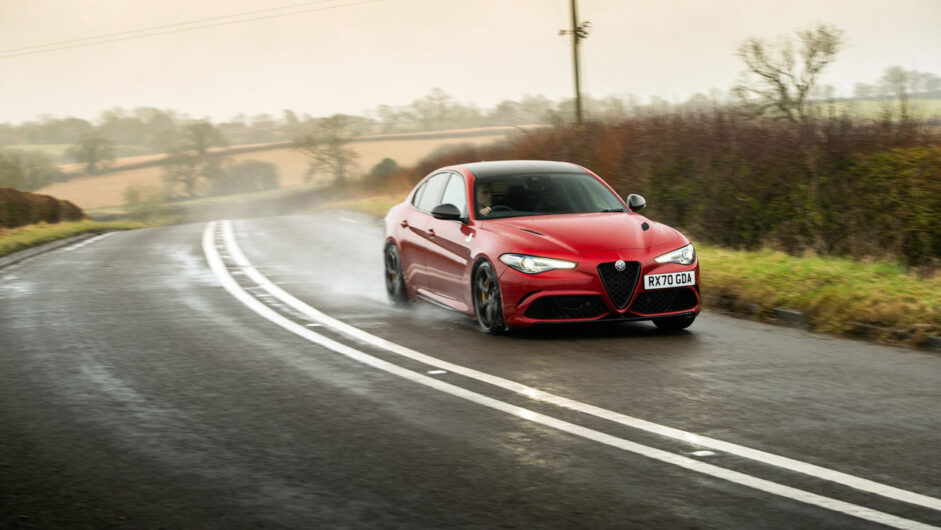
But the Quadrifoglio isn’t the rabid, spiky animal its numbers might suggest. Don’t get us wrong, it’s certainly fast, but the way the performance is delivered from its 2.9-litre V6 is progressive and linear. The engine is muscular from low down and the car’s speed builds rapidly, but in perfect conjunction with the revs. There’s never that heart in your mouth moment when a huge wave of torque takes over, the revs spike and the car squirms in protest. Instead it just powers forward in the manner you dictate.
There’s a suppleness to the chassis which feels odd for a car with such sporting pretensions. The ride is rounded and plush, unlike the firm ride the Alfa’s rivals exhibit. It’s only as you being to really push the Giulia that softer chassis feels slightly lacking in body control, and a touch too much roll is apparent.
But the Giulia’s DNA drive settings allow you to stiffen up the chassis as well as sharpening the throttle, adding weight to the steering and making the exhaust a bit louder. There are four DNA driving modes selected by a small rotary knob on the transmission tunnel. Advanced Efficiency (A) is the most fuel efficient and allows one bank of the V6’s cylinders to shut down.
Next up is Natural (N), but Dynamic (D) and Race (yes, R) are where it gets interesting as the throttle, exhaust, gearshift, suspension and steering all ramp up the involvement.
The heavier steering is useful as it helps to slow your inputs and keep steering wheel movement to a minimum. The exhaust sounds bassier too, and you get either a satisfying crack or a slightly mediocre burp at every upshift. You can never predict which of these noises you’ll get when you pull the paddle though, as it’s not that consistent.
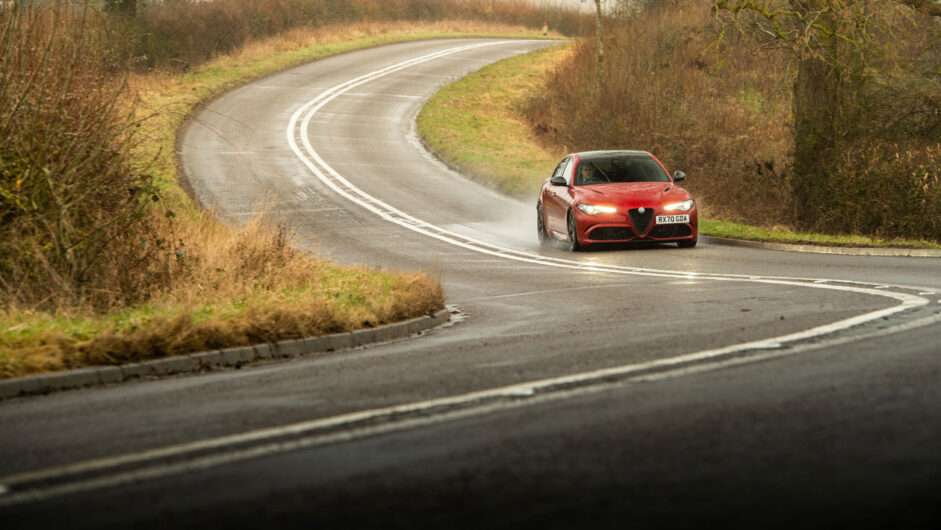
The biggest change is to the chassis however. Dynamic firms up the dampers, but the car still feels compliant. Should you wish to have the noise, steering and throttle of Dynamic with the softest suspension, a button in the middle of the DNA dial allows you to relax the dampers.
Race mode is firmer still, but just as in Dynamic you can back the dampers off to a softer setting; not fully soft, but the same setting as the default in Dynamic. No matter which mode you’re in though, the suspension never feels unbearably stiff. Only the very bumpiest of roads makes Race feel less than ideal, but the slightly tighter body control is still preferred by some of the evo team. Others prefer the more compliant modes, as it never really feels wayward or unrestrained. Either way, there’s a setting to suit everyone.
Race mode also disables the ESP and traction control – it’s the only way to deactivate the safety systems. This might suggest, as well as its name, that Race is a no-go on the road. That is not the case. The chassis and tyres provide so much grip you can still use a lot of throttle in the dry, while the engine’s predictable delivery means it’s easy to judge just how much throttle is necessary to maintain traction. If you’re more brutal with your right foot the tyres will relinquish their hold on the tarmac, but the fast steering means you can instantly react with the exact amount of corrective lock and control the car immediately.
Away from open B-roads and in town the Giulia reveals some slight quirks. It shakes and rocks at idle and the diff is reluctant to lock up; the inside rear wheel often spins as you leave junctions. The carbon ceramic brakes are very hard to modulate at low speeds, and you find yourself fighting the car as it wants to creep forward until you add more and more pressure to the middle pedal to stop it.
These low speed peculiarities are easy to overlook because the Alfa is such an accomplished car when driven enthusiastically. Everything about the way the Giulia behaves is transparent, readable and dependable. As ludicrous as it might seem, the 503bhp, turbocharged, rear-wheel drive Giulia is incredibly approachable.
On track the Giulia’s soft compliant chassis is still more than capable of controlling the saloon. It is best in Race mode where the suspension and steering combine to make it feel supremely agile. The engine and drivetrain also work together to allow a fantastic degree of adjustability, and you can control and balance the car from apex to exit.
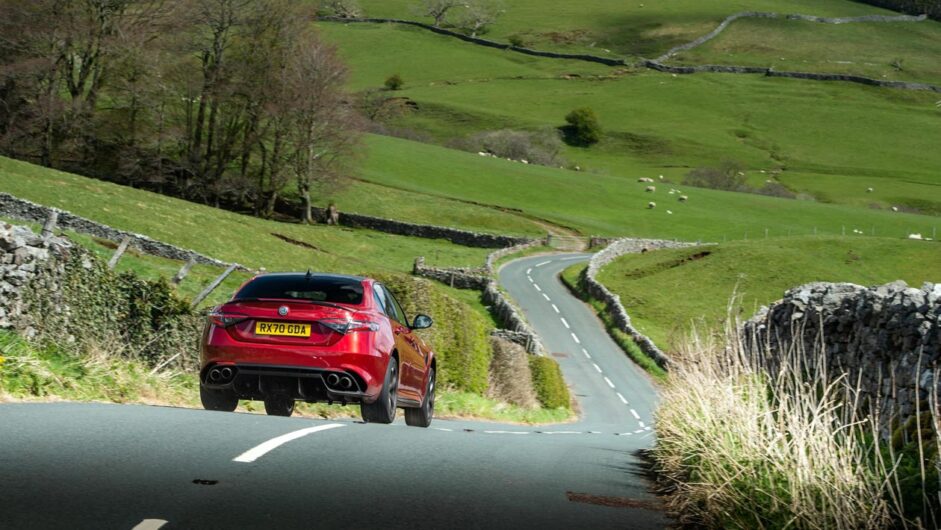
It doesn’t want to play the hooligan like its rivals do. Provoke the Alfa into a slide, which is easy to do thanks to all that power, torque and grippy front end, and the diff seems to want to contradict your actions and push you straight. Keep fighting to maintain the slide by sawing at the wheel and using lots of throttle and it will stay sideways throughout a bend.
After one or two corners of tomfoolery the diff will call time, a message will appear on the dash saying ‘Service ATV System’, it will fail to lock up, acting instead like an open differential. Park it up for five or ten minutes and the diff will have cooled enough for you to continue.
Keep your laps neat and the Alfa is very fast and effective. Keeping the oversteer to a minimum is demanding, but it actually adds to the fun.
Celtic Tuning’s power upgrade (from 503bhp to 585bhp) also causes the Giulia’s clever LSD to have some issues too, even on the road. It doesn’t always lock up when you expect it to and extra power can wasted through wheelspin of one wheel rather than any extra forward momentum. However, when the diff does engage all of the Alfa’s transparency and approachability still remains despite it having to deal with an extra 82bhp. Being able to drive it at a reasonable pace with such comfort and confidence means you can actually use the extra performance from the upgrade too.
> Read our full review of the Celtic Tuning Alfa Romeo Quadrifoglio
- L/100km and running costs
503bhp doesn’t come cheap; don’t expect huge L/100km figures and miniscule fuel bills. Alfa claims the Quadrifoglio will achieve 8.2L/100km on the NEDC combined cycle, but we averaged low 20s during a combination of motorway and B-road driving.
Another expenditure that you should take into account is tyres. The Giulia is fitted with Pirelli P Zero Corsa tyres, 245/35 19s at the front and 285/30 19s at the rear. They cost approximately $350 and $400 each, respectively.
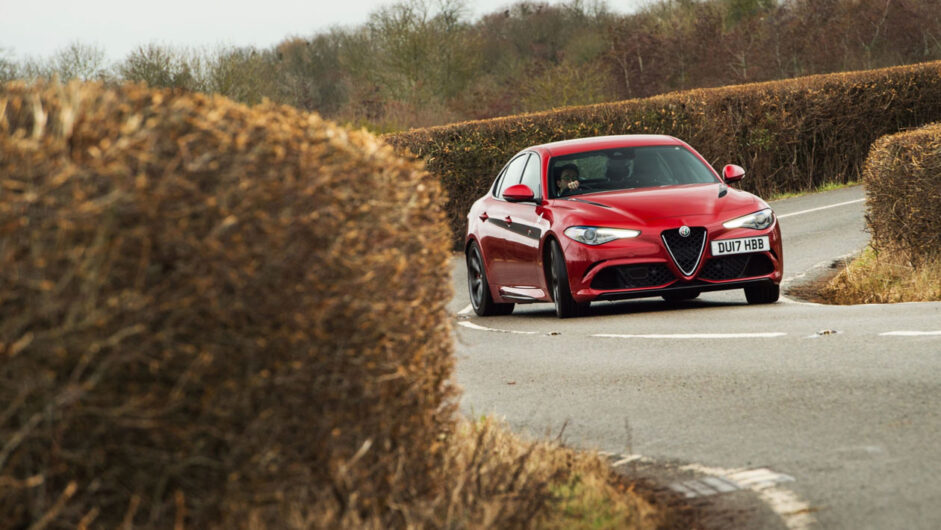
Now, ordinarily with a powerful rear-drive saloon, you’d expect the back tyres to wear faster than the fronts. However, the front tyres fitted to the Giulia test cars that we’ve had access to had a wear rating of 60 (a more conventional performance tyre would have a rating of 300, and an ’eco’ tyre of about 400). Consequently, driving on track rapidly wears down the front tyres.
- Interior and tech
This could be the Giulia’s weakest area. Although the seats and driving position are faultless, and the design of the interior is neat if a little plain, the materials used really let it down; there are lots of tough and scratchy plastics.
The Alfa’s updated infotainment system isn’t bad. The only real issue we have found is when trying to listen to audio via a Bluetooth device, the system takes a long time to reconnect and allow the phone or iPod to play. And, sometimes it refuses to play anything at all. One of the reasons why the Alfa system is a relatively good one is that it doesn’t try to be too complicated; it does everything you need but nothing more.
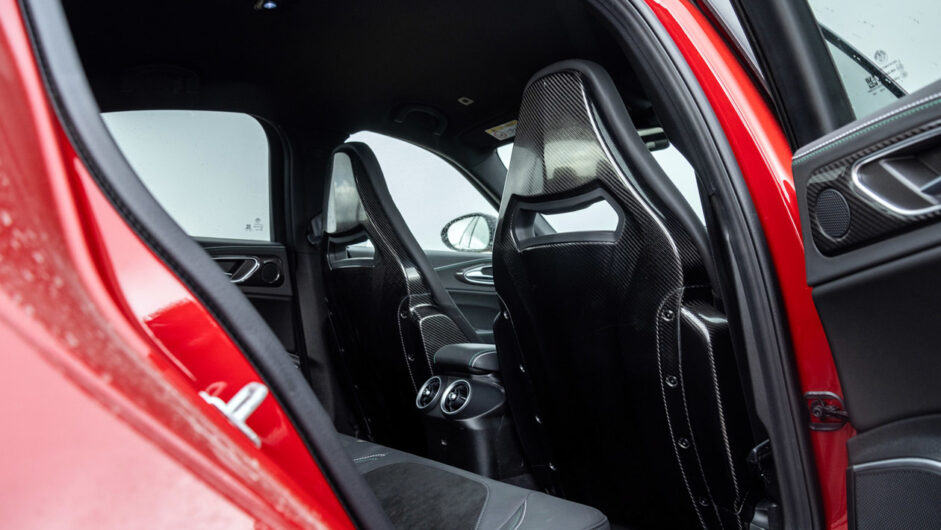
The liberal use of carbonfibre and Alcantara, both of which can be found on the rim of steering wheel, do help give the inside a sporty feel. But there’s no denying it, it’s a long way off the solid, supremely well appointed and well put together interiors of its main rivals from BMW and Mercedes.
- Design
Arguably the Giulia isn’t as outrageous or as pretty as Alfas should be. That’s not to say it isn’t a fine looking car, but it’s only recognisably an Alfa thanks to its huge heart-shaped grille rather than breaking the boundaries of design like Alfas used to.
From the rear the quad exhausts, pronounced diffuser and carbon spoiler give the Giulia some real aggression. It’s so mean that it almost makes the front look a little weedy by comparison.
This article originally appeared at evo.co.uk
Copyright © evo UK, Autovia Publishing

